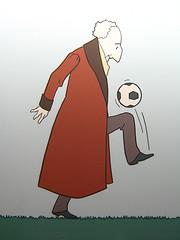
photo : StewieD
Whilst most people know that skiing is Austria’s first and favourite sport, few know what the second most loved activity is amid the Alps. Fußball!
Österreichischer Fußball-Bund (ÖFB)
Founded in 1904, the Österreichischer Fußball-Bund is Austria’s governing body for football. Since then, ÖFB has been a member of the Fédération Internationale de Football Association – more commonly known as FIFA. And with over 150 teams playing at various league levels, football is the country’s second most loved sport.
The history of football in Austria has been beleaguered. The first Championship games were not introduced until 1911 and then they were only for teams in the Lower Austria province – the northeastern-most state surrounding (but not including) Vienna. To place it on the map, it’s the province that borders the Czech Republic and Slovakia.
The 1937-38 season saw the introduction of National League football (Nationalliga) – the highest level of the football championships – with teams from the other 8 states being allowed to play. But the demise of the Nationalliga came abruptly at the end of the season, when the Nazi annexation of Austria occurred.
The Impact of Occupation
During the Anschluß (occupation and annexation of Austria by Germany between 1938 and 1945) most of the Austrian Club Officials and many players at National and local level were murdered or simply disappeared – especially in the Lower Austria province where there was the highest representation of Jews.
Some deaths – like that of Matthias Sindelar, the national star player who died from carbon monoxide poisoning in his apartment – were and remain, subject to much suspicious debate.
The Austrian Nationalliga was also ousted and competitions became integrated into the German system of the Sports Office of the Third Reich. Teams were banned or at best, closed and reopened with new names in an attempt to vanquish anything Austrian. The operation of Junior teams was handed over to the Hitler Youth units, where youngsters between 14 and 18 years were indoctrinated into anti-semitism and motivated to fight faithfully for the Third Reich.
Professional Football
But perhaps equally as devastating was the outlawing of professionalism in football, which rendered Austria at a distinct disadvantage to the rest of the football world. An all Austrian Championship did not emerge until 1949. And even then the football federation remained in conflict, with a split occurring and the formation of the Viennese League resulting.
A more united approach to professional football didn’t develop until 1965, when the Nationalliga was reintroduced. In 1974, 8 of the 9 regional leagues agreed that the Bundesliga (highest level of national league-club competition) should be introduced. The Nationalliga became the second division of football.
Since 1976 unity has prevailed and both levels of competition are now known as Bundesliga – the Nationalliga becoming ‘Bundesliga – Second Division’, Bundesliga being ‘Bundesliga – First Division’.
Football Stadium
Given that most of Austria is mountainous or filled with forestry, where do they play football?
There are 16 stadium of note – 15 at regional League level and the Ernst Happl Stadion at Vienna, home of the National team and which has the largest capacity at 49,800. There are 2 other stadium in the Vienna area.
The smallest stadium for professional football in Austria is Schabelholz Altach, home of SC Rheindorf Altach (10,000 capacity) and situated close to the borders of Switzerland and the Principality of Liechtenstein.
Needless to say, there are many more local playing fields scattered through the valleys. In so far as I’m aware, there aren’t any actually on the mountains – but I wouldn’t put it past the innovative Austrians to have found a plateau somewhere or invented a way of building one amid the ancient massifs?

